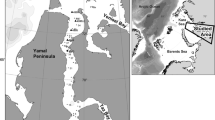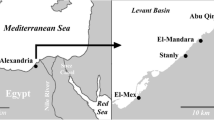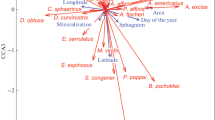Abstract
We studied micro-benthic copepods and cladocerans in the bottom substrates of 12 lakes in the Bol’shezemel’skaya tundra in North-East European Russia during the summer. About 30 species of Cladocera and 28 species and subspecies of Copepoda were found. The majority of the micro-crustaceans are palaearctic or northern palaearctic. But the harpacticoid fauna of the western part of the studied region had specific European features, and three species of the harpacticoid fauna in the eastern part of the region were Siberian. It is therefore a boundary territory for two zoogeographical regions, the arctic and subarctic zones. Acidophilic (Arcticocamptus arcticus (Lilljeborg 1902)) and halophilic (Microsetella norvegica (Boeck 1864)) harpacticoid species were found in the lakes of the eastern part of Bol’shezemel’skaya tundra. On basis of their way of locomotion we distinguished five ecological groups and on basis of their feeding habits four ecological groups of micro-crustaceans. Groups with a similar way of locomotion were likely distributed over the studied water bodies. Habitat (inshore versus offshore), substrate particle size and substrate hardness were of paramount importance for the species distribution.





Similar content being viewed by others
References
Alimov AF (2006) Morphometry of lakes, number of species and biomass of aquatic organisms (in Russian). Biologiya vnutrennih vod 1:3–7
Balushkina EV, Winberg GG (1979) Dependence between mass and body length of planktonic animals (in Russian). In: Obshchie osnovy izucheniya vodnyh ekosistem. Leningrad, pp 169–172
Baranovskaya VK (1978) Crustraceans (Crustacea) (in Russian). In: Getsen MV (ed) Flora i fauna vodoemov evropejskogo severa (na primere ozer Bolshezemelskoy tundry (Flora and fauna of reservoirs of European North (on the example of lakes of Bol’shezemel’skaya tundra). Nauka, Leningrad, pp 174–177
Borutsky EV (1952) Fauna of U.S.S.R. Crustacea. Freshwater Harpacticoida (in Russian), vol. 3(4). Moskva-Leningrad, p 426
Borutsky ЕV (1966) Harpacticoida (Crustacea, Copepoda) of Vashutkin lakes (Usa river basin) (in Russian). In: Belyaev GM et al (ed) Gidrobiologicheskoje izuchenie i rybohozyajstvennoe osvoenie ozer Krajnego Severa SSSR. Moskva, pp 51–52
Chuykov YS (1981) Trophic structure analysis of plankton community (in Russian). In: Winberg GG (ed) Osnovy issledovaniya presnovodnyh ekosistem. ZIN AN USSR Publishing house, Leningrad, pp 45–52
Dole-Olivier M-J, Galassi DMP, Marmonier P, Creuze des Châtelliers M (2000) The biology and ecology of lotic microcrustaceans. Freshwat Biol 44:63–91
Dussart BH, Defaye D (1995) Copepoda: introduction to the Copepoda/guides to the identification of the microinvertebrates of the continental waters of the world. 7. Amsterdam, 277 pp
Fefilova EB (2001) Harpacticoida of North-East European Russia (fauna, ecology, possibility of bioindication (in Russian). Dissertation, Institute of Biology Komi SC UrD RAS
Fefilova EB (2002) Study of plankton fauna of the tundra lakes (in Russian). In: Taskaev AI (ed) Vozobnovimye resursy vodoemov Bol’shezemel’skoy tundry, vol 169. Trudy Komi Nauchnogo Tsentra Uralskogo Otdeleniya RAN, Syktyvkar, pp 33–43
Gorbatsky GV (1967) Physical-geographical division into district in Arctic (in Russian). The band of continental tundras. Moskva
Hakenkamp CC, Morin A (2000) The importance of meiofauna to lotic ecosystem. Freshwat Biol 44:165–175
Isiurova VK (1966) Zooplankton and benthic crustaceans of the lake-river system of the River Verhnyaya Ad’zva basin (in Russian). In: Belyaev GM et al (ed) Gidrobiologicheskoje izuchenie i rybohozyajstvennoe osvoenie ozer Krajnego Severa SSSR. Moskva, pp 37–50
Khokhlova LG (1996) Hydrobiological characteristic of water bodies coastline Barents sea (in Russian). In: Lavrinenko IA (ed) Nekotorye podhody k organizatsii ekologicheskogo monitoringa v usloviyah Severa, vol.147. Trudy Komi Nauchnogo Tsentra Uralskogo Otdeleniya RAN, Syktyvkar, pp 98–110
Konstantinov AS (1979) The main hydrobiology (in Russian). Vysshaya shkola, Moskva
Kurashov EA (1994) Meiobenthos is as a component of lake’s ecosystem (in Russian). Alga-Fond, St-Petersburg
Kurashov EA (2002) The role of meiobenthos in lake ecosystems. Aquat Ecol 36:447–463
Kurashov EA, Slepukhina TD (1988) The use of the system and the experimental approaches for study of the relationship in the benthic communities of the Ladoga lake (in Russian). In: Skarlato OA (ed) Gidrobiologicheskie issledovaniya morskih i presnyh vod. Leningrad, pp 60–67
Loskutova OA, Fefilova EB (1996) Hydrobiological characteristic of the lakes of Bol’shezemel’skaya tundra (in Russian). In: Lavrinenko IA (ed) Nekotorye podhody k organizatsii ekologicheskogo monitoringa v usloviyah Severa, vol.147. Trudy Komi Nauchnogo Tsentra Uralskogo Otdeleniya RAN, Syktyvkar, pp 125–138
McCune B, Mefford MJ (1999) PC-ORD. Multivariate analysis of ecological data. Version 4.35. MjM Software, Gleneden Beach, Oregon, USA
Monakov AV (1976) Nutrition and trophic relations of freshwater Copepoda (in Russian). Leningrad
Monakov AV (1998) Nutrition of freshwater invertebrates (in Russian). Moskva
Naberezhny AI, Irmasheva SG (1980) Correlation between measures and weight of body in harpacticoids (Crustacea: Harpacticoida) (in Russian). Izv AN MSSR Ser Biol Chem Sci 4:75–76
Noodt W (1970) Zur Ökologie der Copepoda Harpacticoida des Küstengebietes von Tvärminne (Finland) Acta zool Fennica 128. Helsinki-Helsingfors, 35
Ponomarev V, Loskutova O (2006) Diversity of zoobenthos and fish communities of lakes in the Kara Sea basin. Verh Int Ver Limnol 29:1715–1718
Popova EI (1976) Bottom fauna of the Bolshoi Kharbei Lake and its production (in Russian). In: Winberg GG, Vlasova TA (eds) Produktivnost’ ozer vostochnoj chasti Bolchezemelskoj tundry. Leningrad, pp 101–103
Ruhin LB (1953) Bases of the litology (in Russian). Gos. Nauchno-tehn Izd-vo neft’anoy i gorno-toplivnoy lit-ry, Moskva-Leningrad
Rundle SD, Bilton DT, Shiozawa DK (2000) Global and regional patterns in lotic meiofauna. Freshwat Biol 44:123–134
Rylov VM (1917) Materials to the fauna of free-living Copepoda of Northern Russia (in Russian). Vol. XXII. Ezhegodnik Zoologicheskogo muzeya Rossiyskoi AN. (Annual of zoological museum of Russian AS). Izdatel’stvo Rossiyskoy Akademii nauk, Petrograd 1:247–310
Rylov VM (1918) Materials to the fauna of free-living Copepoda of Northern Russia (in Russian). Vol. XXIII. Ezhegodnik Zoologicheskogo muzeya Rossiyskoi AN. (Annual of zoological museum of Russian AS). Izdatel’stvo Rossiyskoy Akademii nauk, Petrograd 2:43–96
Rylov VM (1948) Freshwater Cyclopoida (in Russian). In: Fauna SSSR. Rakoobraznye, vol 3(3). Nauka, Leningrad, 319 pp
Sarvala J (1986) Patterns of benthic copepod assemblages in an oligotrophic lake. Ann Zool Fennici 23:101–130
Sarvala J (1998) Ecology and role of benthic copepods in northern lakes. J Mar Syst 15:75–86
Schmid-Araya JM, Schmid PE (2000) Trophic relationships: integrating meiofauna into a realistic benthic food web. Freshwat Biol 44:149–163
Shubina VN (1986) Hydrobiology of the Salmon river in the northern Urals (in Russian). Nauka, Leningrad
Skvortsov VV (1997) Meiobenthos communities of some subarctic lakes. Hydrobiologia 342/343:117–124
Smirnov NN (1976) World Macrothricidae and Moinidae faunas (in Russian). In: Fauna SSSR. Rakoobraznye, vol1:3. Nauka, Leningrad, 273 pp
Statistica 6.0. (2001) Statistica (data analysis software system), version 6 by StatSoft. Inc
Vehov NV (1982) Fauna and life cycle peculiarities of Copepoda of subspecies Cyclopoida and Calanoida of arctic and subarctic reservoirs of Europe (in Russian). Hydrobiol J 2:18–25
Vlasova TA (1976) Hydrobiological and hydrochemical conditions of the biological productivity in the Kharbey Lakes System (in Russian). In: Winberg GG, Vlasova TA (ed) Produktivnost’ ozer vostochnoj chasti Bolchezemelskoj tundry. Leningrad, pp 6–26
Acknowledgments
This research was supported by grant from the Russian Foundation for Basic Research (RFBR) No. 98-04-50007-a, the international projects “Sustainable development of the Pechora region in a changing Society and Environment”—SPICE (contract EC No. ICA2-CT-2000-10018) and “Pechora River Basin Integrated System Management” (PRISM) 2003–2005. We thank our colleague Vasily I. Ponomarev for samples and data about lakes 1–8 kindly given. We wish to thank also Anna Loskutova for help in translation and Vivienne Jones for kindly checking the English of the manuscript. We are grateful to three anonymous reviewers for their valuable comments and suggestions on an earlier draft of this article.
Author information
Authors and Affiliations
Corresponding author
Rights and permissions
About this article
Cite this article
Fefilova, E.B., Loskutova, O.A. & Pestov, S.V. Micro-benthic crustacean communities in tundra lakes of North-East European Russia. Aquat Ecol 42, 449–461 (2008). https://doi.org/10.1007/s10452-007-9109-z
Received:
Accepted:
Published:
Issue Date:
DOI: https://doi.org/10.1007/s10452-007-9109-z




